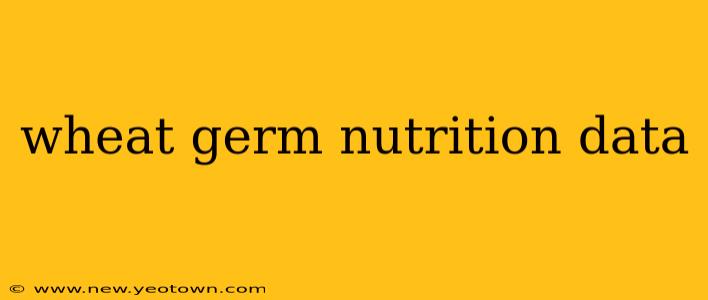Wheat germ, that tiny, nutrient-packed heart of the wheat kernel, often gets overlooked. But for those in the know, it's a culinary treasure trove brimming with vitamins, minerals, and antioxidants. Let's embark on a journey to uncover the remarkable nutritional profile of this often-underappreciated ingredient and explore why it deserves a prominent place in your diet.
Imagine a tiny, golden speck, barely visible to the naked eye, yet holding within it the potential for vibrant health. That's wheat germ. This powerhouse of nutrition is the embryo of the wheat kernel, the part responsible for sprouting into a new plant. It's packed with essential nutrients often lost in the refining process that transforms whole wheat into white flour.
What are the key nutrients found in wheat germ?
Wheat germ boasts an impressive array of vitamins and minerals. It's a significant source of vitamin E, a powerful antioxidant that protects your cells from damage. It's also rich in B vitamins, crucial for energy production and nerve function. Think thiamin (B1), riboflavin (B2), niacin (B3), and folate (B9) – all playing essential roles in maintaining optimal health. Beyond vitamins, wheat germ is a good source of minerals like iron, magnesium, zinc, and selenium, contributing to various bodily functions, from oxygen transport to immune system support. It's also a decent source of fiber, beneficial for digestive health.
Is wheat germ high in protein?
Yes, wheat germ is a surprisingly good source of protein, providing essential amino acids your body needs to build and repair tissues. While not as protein-dense as some other sources, its protein content adds to its overall nutritional profile. This makes it a valuable addition to vegetarian and vegan diets, supplementing the intake of essential amino acids.
What are the health benefits of eating wheat germ?
The nutritional richness of wheat germ translates into a plethora of potential health benefits. Its high antioxidant content helps combat oxidative stress, potentially reducing the risk of chronic diseases. The fiber content aids in digestion and promotes healthy bowel movements, preventing constipation. The B vitamins support energy levels and neurological function, while the minerals contribute to various bodily processes. Some studies even suggest that wheat germ may help lower cholesterol levels and improve blood sugar control, although more research is needed in these areas.
How many calories are in wheat germ?
A typical serving of wheat germ (around 1 ounce or 28 grams) contains approximately 100-120 calories. This calorie count is fairly low, especially considering its considerable nutrient density.
How can I add wheat germ to my diet?
Integrating wheat germ into your daily routine is surprisingly easy. You can sprinkle it over your cereal, yogurt, or oatmeal for a boost of nutrition. It can also be added to baked goods like muffins, bread, and pancakes, subtly enriching their flavor and nutritional value. Some even incorporate it into smoothies or homemade granola for an extra textural and nutritional kick. Remember to store it in an airtight container in the refrigerator to maintain its freshness and nutritional value.
What are the potential drawbacks of consuming wheat germ?
While largely beneficial, wheat germ does come with a few potential drawbacks. Individuals with wheat allergies should obviously avoid it. Due to its high fiber content, consuming large quantities could cause digestive discomfort like bloating or gas. Starting with small amounts and gradually increasing intake is advisable. Additionally, because it’s a seed, it can contain phytates, which can interfere with mineral absorption, although this is often mitigated by proper food preparation.
Wheat germ, with its impressive nutrient profile, offers a simple yet effective way to enhance your diet. It's a testament to the power of nature, reminding us that even the smallest of ingredients can hold the key to vibrant health. Remember to consult with a healthcare professional or registered dietitian before making significant changes to your diet, especially if you have underlying health conditions.

